A couple weeks ago I was talking with one of my old art buddies, who I used to do a lot of photography with, and mentioned Erwin Olaf.
Olaf was in my mind, when I commented about him here and someone pointed out that Olaf had, literally, died that morning. Naturally, I thought “he wasn’t that old!” but it was complications from emphesyma, not a more typical disease of old age.
Olaf had a great, weird, sense of creativity, which always resonated strongly with me. He was a studio photographer who did a lot of commercial work, but his personal art seemed to enjoy digging at the boundary between social expectations and the deeper reality of how things actually are. Another thing I always enjoyed about Olaf was that he clearly was on some kind of trajectory – he didn’t just come up with a winning formula, and turn the crank thereafter. He wandered into body horror, social horror, political horror, uh… See why I liked him? Whenever a new book of his stuff came out, I would buy 2 copies and bag and store one. Mostly because I once sold a copy of Chessmen on amazon for $800 once it was out of print and rare. Also, I was able to sometimes give a budding artist a copy of one of his books, if they fell in love with it as I had.
When he did Chessmen I was early in my black and white darkroom days, studying Adams’ Zone System and trying to get perfect exposures. I stumbled across Chessmen and immediately recognized the silky, textured silvery look of perfect exposures and prints. The content was weird but, damn, that guy understood light. Years later, Olaf evolved his understanding of light to producing elaborate sets, costing tens of thousands of dollars, and placing carefully selected actors into them, to tell oblique stories of disenchantment and isolation. This one is one of my favorites:
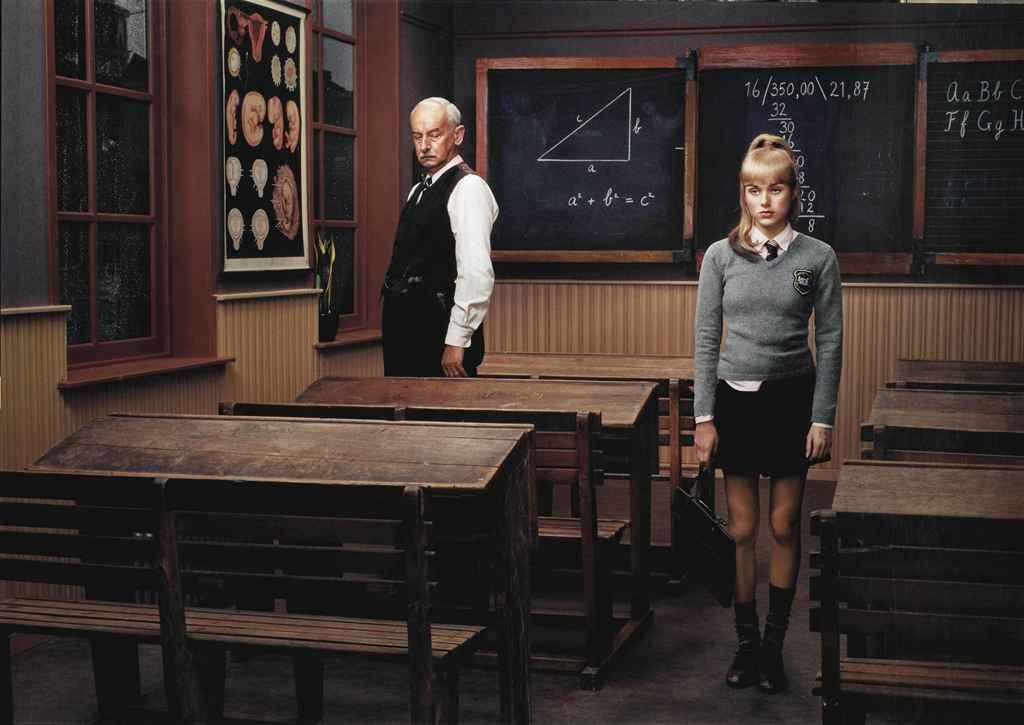
I don’t need to meander about the story in the picture. Let’s talk about the lighting, instead! How did he get that amazing, silky, even, light? Simple: you build a cinematic set, like the sort Hollywood studios use for certain looks in movies. For example, if you’ve seen Sleepy Hollow it was almost entirely shot in sets like this – a frame of a room that is mostly completely constructed, without a ceiling, so you can lower a couple gigantic Plume LightBanks in to give that omnidirectional soft-but-intense light. The big light banks can be dialed carefully in individual cells so that you can do things like carefully shadow the right hand side (camera right) of the girl, without creating a contradictory shadow, elsewhere. Look at the shadow cast by the window sill and you can see where the light is mostly coming from. Look at the shadows not quite cast on the floors by the benches and you can see how omnidirectional the light is.
Another artist who works in a similar vein is Gregory Crewdson, who uses cinematic sets and outdoor cinematic lighting gear, to create images with similar surreal depth and clarity. I used to be concerned that it was just a “schtick” i.e.: “hey lets use extremely expensive gear and that’ll serve as a barrier to entry for lesser mortals.” I think it’s sincere, though. Both Crewdson and Olaf produced highly marketable “fine art” images by shooting this sort of stuff with large format film cameras, scanning huge negatives at high density, photoshopping every single pixel, then printing the results on giant aluminum plates that were so expensive they tended to go right into collectors’ hands.
The whole Hope monograph is great, if you like this sort of stuff. It features people in potentially emotional and conflicted scenarios, standing around looking disassociated and detached.
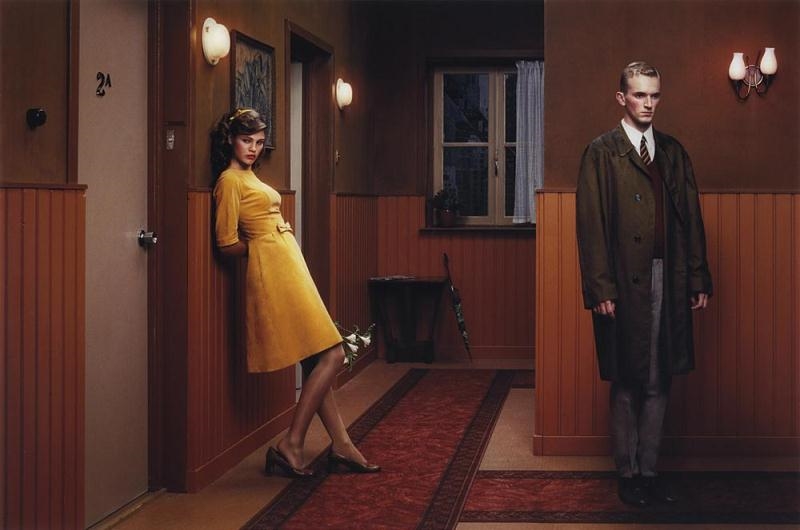
What is going on here? She’s got lilies (vedic symbols of death), the apartment door of 2B is open,. there’s an umbrella, he’s wearing a raincoat, she looks … anywhere but at him, and he looks away, too.
I have a theory about such art: the artist generally does not think much about what’s going on in the picture. If you do that, you wind up making it too obvious. Instead, you create some semiotic relationships and let the viewer do the work. Someone who was not comfortable with trigonometry might interpret the classroom image as about the stress of learning math, whereas someone who was concerned with child abuse might interpret something quite different. All I can say is to lift a line from Tuxedomoon’s Ghost Sonata: “Every story is about death.”
So, after talking about Olaf’s work, I naturally ran over to Midjourney and asked it to create a few “… in the style of” images, possibly while unknown to me he was breathing his last. That’s some negative serendipity, right there, but I think he’d have found it funny or funny-ish.
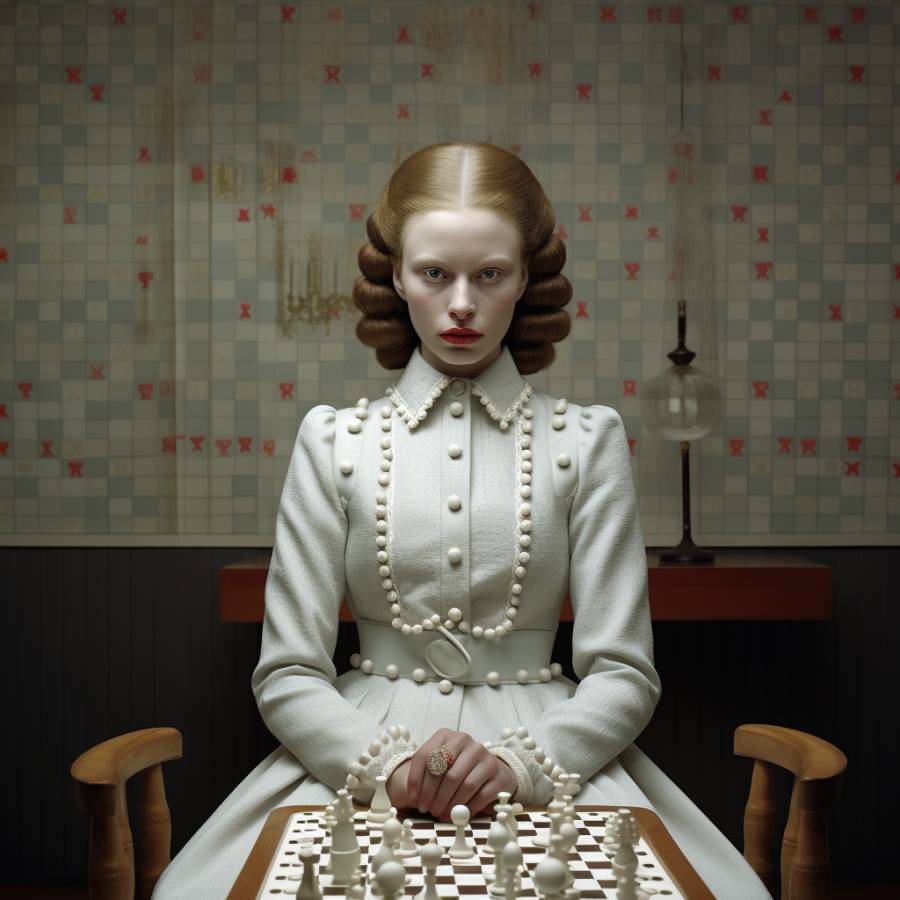
Midjourney AI and mjr: “an unpublished photo by Erwin Olaf”
Remember: what the AI does is starts with an image full of noise, then successively removes or alters pixels that don’t look like an unpublished photo by Erwin Olaf. It categorically does not “understand” Olaf’s work, nor does it even have a notion of Olaf’s style. All it has is a huge knowledge-base of probabilities of relationships co-occurring in an image. Or something like that. I’m going to confess something you’ve probably noticed already: I am fascinated and blown away by this stuff.
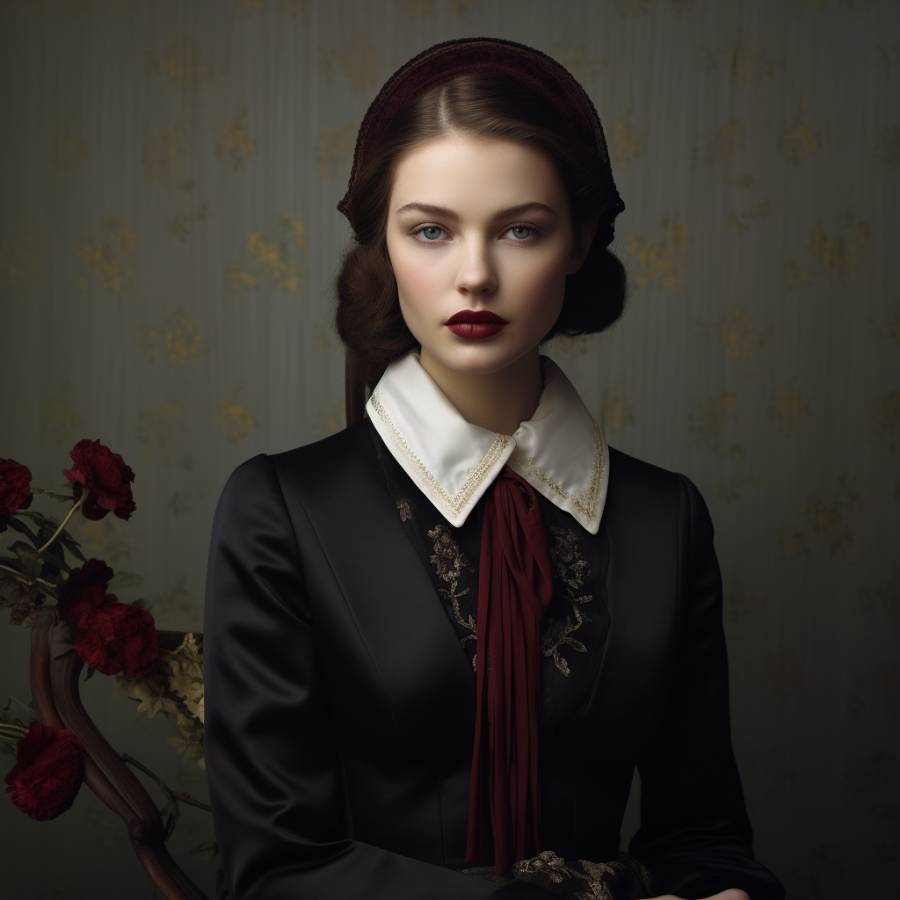
Midjourney AI and mjr: “an unpublished photo by Erwin Olaf”
Now, I am wondering if I should have asked “… from the book Chessmen” but I didn’t.
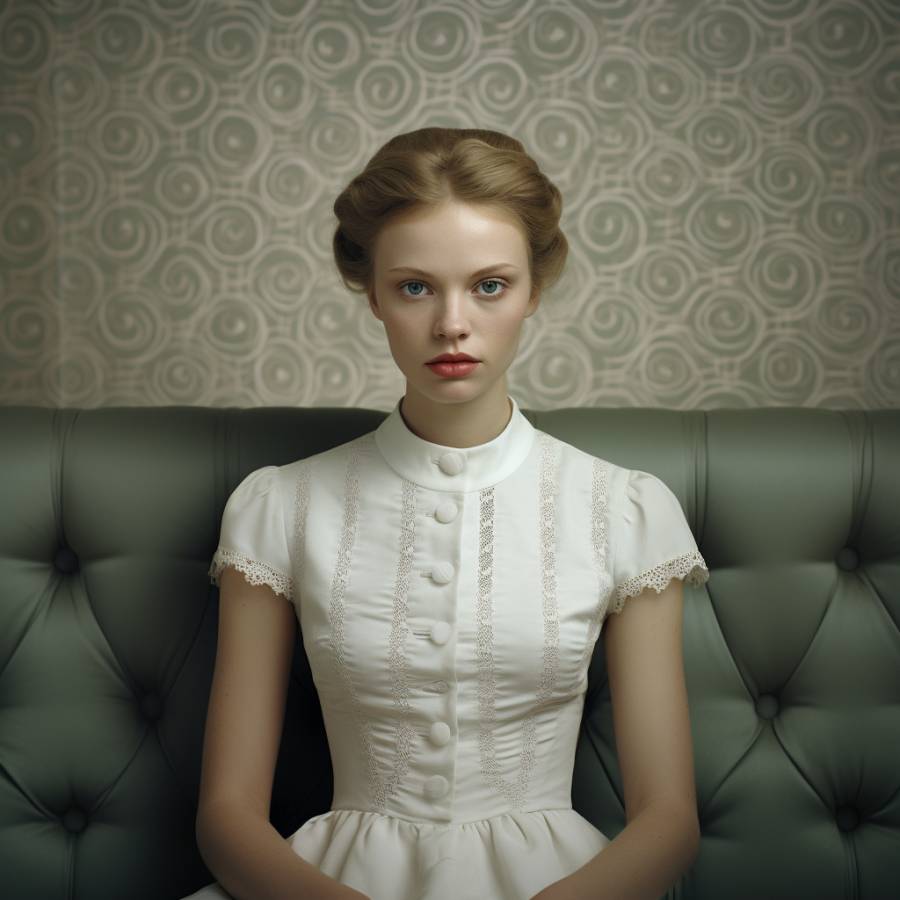
Midjourney AI and mjr: “an unpublished photo by Erwin Olaf”
We recently had a pointed exchange in some comments, about the topic of copyright. I ought to do a posting on the topic, carefully demarcating it as “… this is all my opinion” but I think you would find it problematic to say that these images do not represent a sort of a threat to Erwin Olaf, if he wanted to maintain a “signature style.” Did you notice she is missing a crucial button in the image above? Tell me what could be more “… in the style of Erwin Olaf” than that!
I’ll answer a bit ahead of myself: the reason I like Erwin Olaf’s work is exactly because he was a moving target. He had “a style of Erwin Olaf” because there were certain things he seemed to like, too, but he did not settle into a single style and just turn the crank from there. AI art is not threatening to someone like that, exactly.
On my best day, if I loaded up some Fuji color film and spent a week on my lighting, I could have produced an image approximately like the one above, but if I did I’d be doing exactly the same thing as the AI – remixing probabilities of someone else’s work into my own selection of probabilities. If copyright is to have any meaning, it would protect Olaf from the creation of works like the image above, or it would have to acknowledge that “the look” is not copyrightable. It’s probably impossible to copyright “the look” because at a certain level all human imagery is derivative – art is a reflection of an idea about the world surrounding us – there is no other way to comprehend it.
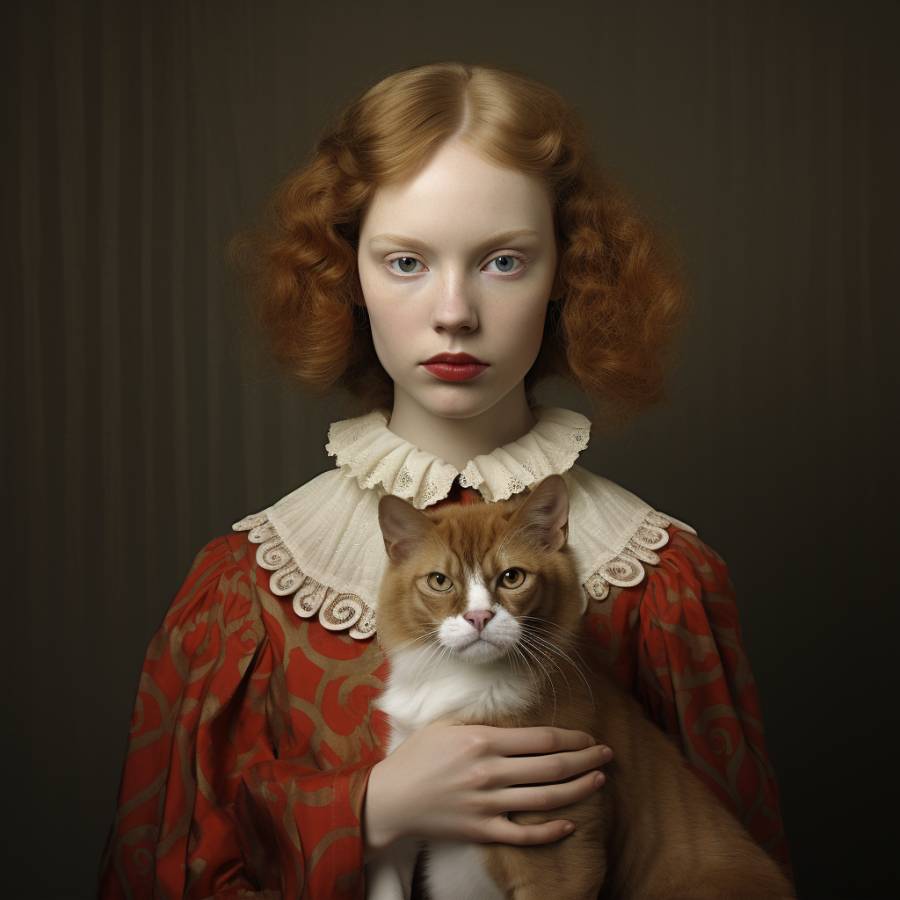
Midjourney AI and mjr: “an unpublished photo by Erwin Olaf”
Is GrumpyCat copyrighted? No, we observe that there is a cat with a unique face that we interpret as a human expression, and that cat is all over the memeosphere. So the AI grinds the cat into its probability tensor field and sometimes when someone asks for an image, and the pixels in a certain area look cat-like, it makes them more and more cat-like and a high probability cat face is grumpy cat.
I’m going to go out on a limb, here, and offer a hypothetical: it is impossible for AI to “steal” a copyrighted image, because really it’s just saying “the dice of the universe led me in this direction.” There is no intentionality and stealing takes intent.

Midjourney AI and mjr: “an unpublished image by erwin olaf from his book chessmen”
It’s wrong, but it’s also right because it’s very typical of Olaf: he loved weird headgear, cloth-wrapped people tied with twine, and he’d have loved the chess board pattern coat. But if it was from Chessmen it would have been shot on Tmax film with a Hasselblad. The AI, being “just an AI” did not have the understanding of Olaf’s work necessary to produce the correct image. I, as a critical viewer, could fix this by providing the additional information:
/imagine an unpublished image by erwin olaf from his book “chessmen”. shot on tmax film with a hasselblad, black and white, hyper detailed zone system print.
Boom:

Midjourney AI and mjr: “an unpublished image by erwin olaf from his book “chessmen”. shot on tmax film with a hasselblad, black and white, hyper detailed zone system print. “
It’s still not an image that would fit in with the rest of the book Chessmen – it’s getting there, though.
Anyhow, thank you for all the amazing art, Erwin Olaf. I’ll miss seeing new stuff from you on a periodic basis.

Olaf’s last exhibition imagined him living in a pandemic. [koreajoongangdaily] It’s brilliant, beautiful, unsettling, and pretty typical Erwin Olaf work. Many artists responded to the pandemic by being bored enough to create good stuff. I’m not going to repost any more of his stuff here, but rather I’ll just encourage you do take a look around the internet, or his personal site: https://www.erwinolaf.com/

I do not know the book “Chessmen”. Those midjourney pictures do look interesting but what bugs me is that the first lady has six fingers. And what bugs me even more is that all the chessboard and chess pieces are wrong. As a chess player, this causes me immense pain and needless suffering /curls up into a ball and tries to forget the disturbing images/.
Joking aside, the AI is impressive, even if it is fundamentally dumb. And I think that copyright laws need to be severely revised, and patent laws as well. In my opinion, the copyright for any work done by an individual or a small group of individuals like books and music should not be transferable from the author(s) to anyone else, neither through sale nor inheritance – once the author dies, it should automatically enter the public domain, full stop, and as long as the author lives, they can rent out the rights to reproduce said work, but never to concede them. Only people should be capable of owning copyright of such things, corporations should be prohibited.
Copyrights for huge works actually done by corporations, like Hollywood movies and similar, should have a time limit of ten or twenty years or so and after that enter the public domain too. What Disney is currently and enthusiastically doing to anyone daring to use the likeness of Mickey Mouse in any context, even context that is absolutely and undeniably fair use, is indefensible. In my opinion.
In what classroom does a teacher provide lessons in both the Pythagorean Theorem and the alphabet?
I think midjourney does not grok chess.
@2: In a one-room schoolhouse.
Midjourney girl #3: Which is more intriguing, the missing button or the slightly crooked philtrum?
Now you can’t un-see it.
Pythagorean theorem, the alphabet, long division AND human gestation…
The interesting thing is less that midjourney does not grok chess, but that the images on which midjourney was trained did not. I have a feeling that ai, like so many technologies, will turn out to be a mirror. It sees us in ways we cannot see ourselves.
I also wonder if this stuff can be reversed. It should be possible to ask whether something is in the style of a particular artist and get a pretty useful answer.
Ian King@#6:
The interesting thing is less that midjourney does not grok chess, but that the images on which midjourney was trained did not. I have a feeling that ai, like so many technologies, will turn out to be a mirror. It sees us in ways we cannot see ourselves.
Absolutely correct.
Many liberals have voiced concern that AI will produce – for example – racial bias in its decision-making output. But it appears to me that is not so much the case as that it will reproduce the racial bias reflected in a racist civilization. Still sucks! Maybe sucks worse!
I also wonder if this stuff can be reversed. It should be possible to ask whether something is in the style of a particular artist and get a pretty useful answer.
It sort of can. There are other AIs trained to categorize stuff, e.g. “deepboru” – you can give it a picture and it does a fairly impressive job of trying to give you back a prompt you could hand to another AI and say “make this” and then you get … nothing that bears any resemblance at all. Because the vocabulary the analysis AI uses to produce its output is different from the vocabulary the generative AI uses for its input. So Deepboru might say “a picture of an old man playing chess” whereas to get that output you’d want to say “an unpublished image from Erwin Olaf’s Chessmen” – which implies that I have just added knowledge to the situation, so it’s not really the AI doing the analysis any more. Thought experiment: someone who was not an Erwin Olaf fan would not recognize the style, and therefore would never think to bump the probabilities on “Erwin Olaf” with his name.